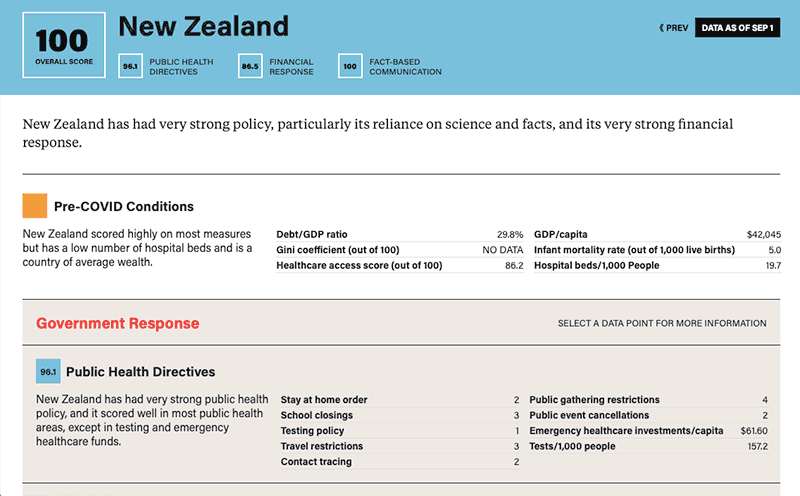Public health is a convenient pretext for extending authoritarian controls.
Russia
- Data as of Aug 1
- Next 》
- 81.2 Public Health
Directives - 25.7 Financial
Response - 16 Fact-Based
Communication
- 81.2 Public Health
Directives - 25.7 Financial
Response - 16 Fact-Based
Communication
Russia has a relatively weak score, with strong public health policy undone by weak financial support, limitations on press freedom, and spread of misinformation about the pandemic.
Pre-COVID Conditions
Russia was relatively strong in pre-pandemic preparedness but is not a wealthy country, and it scores near the median for hospital beds and healthcare quality and access to care.
- Debt/GDP ratio 14.6%
- GDP/capita $30,820
- Gini coefficient (out of 100) 37.5
- Infant mortality rate (out of 1,000 live births) 6
- Healthcare access score (out of 100) 71.7
- Hospital beds/1,000 People 59.1
Government Response
Select a data point for more information(Data points represent policy level as of Aug 1.)
Public Health Directives
Russia has had a relatively strong public health policy, owing to restrictions on social gatherings, although it does limit who can get tested and has little emergency healthcare spending related to COVID-19.
- Stay at home order 2
- Public gathering restrictions 4
- School closings 0
- Public event cancellations 2
- Testing policy 3
- Emergency healthcare investments/capita $13.57
- Travel restrictions 1
- Tests/1,000 people 1.9
- Contact tracing 2
Financial Response
Russia’s financial response is relatively weak; its stimulus is small, and it has very little income support.
- Financial stimulus as share of GDP 3.4%
- Income support 1
- Debt forebearance 2
Fact-Based Communication
Russia scores low in this category, as it has propagated false information on COVID-19 and has greatly limited press freedom in response to the pandemic.
- Reliance on science/fact based information 2
- Press freedom 3
COVID-19 Status as of Aug 1
Russia has a relatively strong score in this category, with a low death rate that is counterbalanced by a very high case rate; limited communication of facts and restrictions on press freedom regarding COVID-19 raise concerns about the accuracy of the data.
- Total deaths 13,963
- Death rate per 100K 95.7
- Total cases 839,981
- Cases per 100K 5,756
- Percent of positive tests 2.1
| Date | Status | New Cases/1M | |
|---|---|---|---|
| 1 | Jun 08 | Retail and restaurants start to reopen (varies by region) | 60.53 |
| 2 | Jun 22 | Final restrictions are lifted, including on gyms and restaurants | 54.54 |
Differentiating Factors
- False news law limited press freedom: Press freedom in Russia has been severely curtailed by the passage of a law which makes spreading 'false information' about coronavirus punishable by up to five years in prison. The law is similar to those passed in Hungary and India. Read More
- Amendment allows Putin to stay in power: Russians voted in early July to pass a constitutional amendment that allows President Putin to serve a further two terms, keeping him in power until 2036, and consolidating his control of the country. Golos, an independent Russian election monitoring group, has condemned the vote, saying it received over 2000 complaints of violations of democracy. Read More
- Government likely consolidating power through travel restrictions: Putin has been accused of using the pandemic to consolidate his power and control over the country. In addition to the constitutional amendment, campaigners have condemned the implementation of a new 'digital pass' system which requires Russians to get permission to travel by vehicle or public transport due to the pandemic. Read More
Compared with Other Arctic States
-
77.7Canada 116,298
Cases 3,081
Per 1M 8,935
DeathsCanada has a relatively strong score, with poor public health policy countered by a continued reliance on fact-based communication.
-
27.7United States 4,562,037
Cases 13,783
Per 1M 153,314
DeathsStill battling widespread COVID-19 cases and deaths, which were exacerbated by the former administration's limited use of facts and science, limited emergency healthcare spending, and limited debt relief, the Biden administration, by contrast, is taking aggressive action to combat the virus, although it may take time for the score to reflect these changes.
-
71.9Norway 9,208
Cases 1,699
Per 1M 255
DeathsNorway scores just below the median, pulled down by its weak public health and financial response scores, despite a strong reliance on facts and a free press.
-
51.6Sweden 76,937
Cases 7,618
Per 1M 5,762
DeathsDespite being known for a relatively strong public healthcare system, Sweden has been hit hard with cases; the country’s lack of stay-at-home orders and school closures, limited testing, and few gathering restrictions overshadowed its financial support, reliance on facts, and accountability with an open press.
Further Reading From Foreign Policy
Be the source of actionable insight.
Select one of the subscription options below to read the full Covid-19 Global Response Index. Unlock even more global intelligence with a subscription to FP Insider.
Already an FP Insider? Log In
Looking for group access? Contact us directly

Statistics and government response factors available on each country profile include:
Pre-COVID Conditions:
- Debt to GDP ratio
- Infant mortality rates
- Hospital beds per 1,000 people
- Gini coefficients measuring inequality
- Health access and quality
COVID-19 Public Health Directives:
- Stay-at home orders
- School-closing policy
- Public-gathering restrictions
- Cancellation of public events
- Testing policy and rates per 1,000 people
- Emergency healthcare spending per capita
- Travel restrictions
- Contact tracing
COVID-19 Financial Response:
- Stimulus package as a share of GDP
- Income support
- Debt-forbearance
Public Communications:
- Instances of misinformation by leadership
- Limitations on press freedom, censorship
Current/Historic In-Country COVID-19 Status:
- Death rates per 1 million
- Case rates per 1 million



